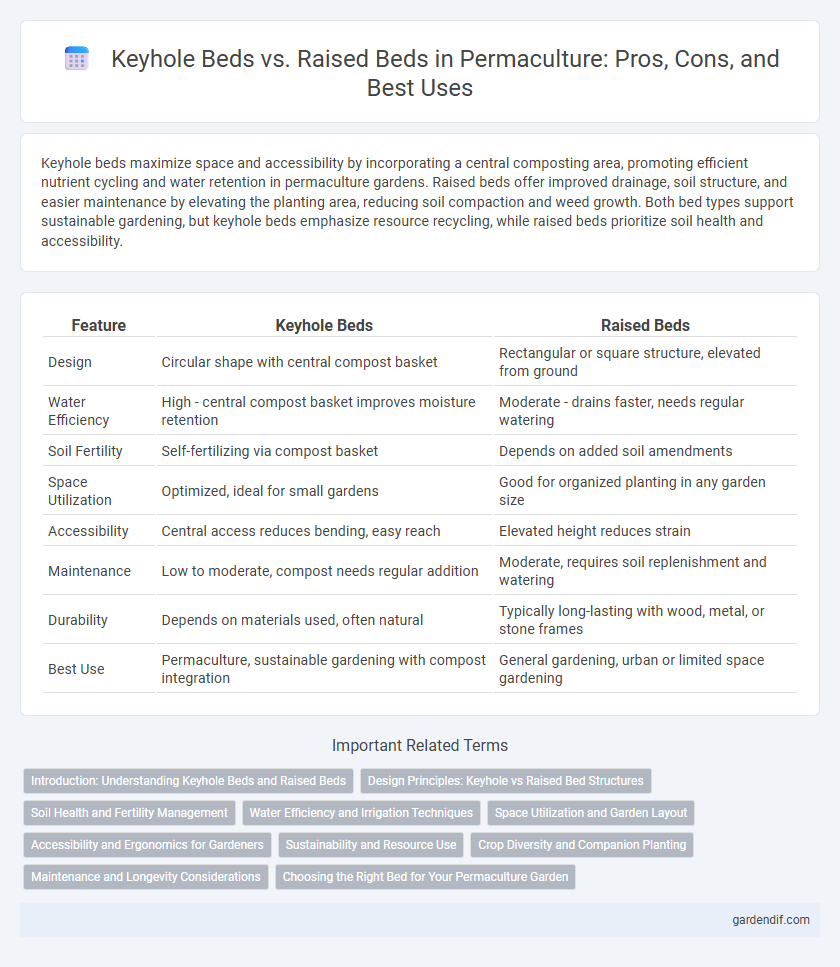
keyhole beds vs raised beds Illustration
Keyhole beds maximize space and accessibility by incorporating a central composting area, promoting efficient nutrient cycling and water retention in permaculture gardens. Raised beds offer improved drainage, soil structure, and easier maintenance by elevating the planting area, reducing soil compaction and weed growth. Both bed types support sustainable gardening, but keyhole beds emphasize resource recycling, while raised beds prioritize soil health and accessibility.
Table of Comparison
| Feature | Keyhole Beds | Raised Beds |
|---|---|---|
| Design | Circular shape with central compost basket | Rectangular or square structure, elevated from ground |
| Water Efficiency | High - central compost basket improves moisture retention | Moderate - drains faster, needs regular watering |
| Soil Fertility | Self-fertilizing via compost basket | Depends on added soil amendments |
| Space Utilization | Optimized, ideal for small gardens | Good for organized planting in any garden size |
| Accessibility | Central access reduces bending, easy reach | Elevated height reduces strain |
| Maintenance | Low to moderate, compost needs regular addition | Moderate, requires soil replenishment and watering |
| Durability | Depends on materials used, often natural | Typically long-lasting with wood, metal, or stone frames |
| Best Use | Permaculture, sustainable gardening with compost integration | General gardening, urban or limited space gardening |
Introduction: Understanding Keyhole Beds and Raised Beds
Keyhole beds feature a circular layout with a central compost basket, maximizing space and nutrient recycling for intensive gardening. Raised beds provide elevated planting areas with improved soil drainage and easier access, ideal for controlling soil quality and reducing pests. Both designs promote sustainable permaculture practices by enhancing soil health and efficient water usage.
Design Principles: Keyhole vs Raised Bed Structures
Keyhole beds maximize space efficiency through a circular design with a central composting basket, promoting nutrient cycling and easy access for maintenance. Raised beds provide controlled soil environments, improving drainage and root development while allowing customization of depth and shape to suit specific crops. Both structures embody permaculture principles by enhancing soil health and optimizing plant growth, but keyhole beds prioritize resource recycling, whereas raised beds focus on soil management.
Soil Health and Fertility Management
Keyhole beds optimize soil health by concentrating compost and organic matter in the central basket, promoting microbial activity and nutrient cycling directly to surrounding plants, while raised beds improve drainage and prevent soil compaction but may require more frequent soil amendments to maintain fertility. The circular design of keyhole beds allows for efficient water retention and root access, enhancing soil structure and nutrient availability naturally over time. Raised beds enable controlled soil composition and aeration but often depend on external inputs like organic fertilizers or cover crops to sustain long-term soil fertility.
Water Efficiency and Irrigation Techniques
Keyhole beds optimize water efficiency through a central composting basket that retains moisture and recycles nutrients, reducing irrigation needs compared to traditional raised beds. Their design promotes even water distribution and minimizes runoff by directing water inward, while raised beds often require more frequent watering due to exposed soil surfaces. Utilizing drip irrigation or soaker hoses in both systems enhances water conservation by delivering moisture directly to plant roots and limiting evaporation.
Space Utilization and Garden Layout
Keyhole beds maximize space utilization by incorporating a central composting area, allowing gardeners to access all parts of the bed without compacting soil, which optimizes plant growth and reduces waste of garden space. Raised beds offer modular garden layout flexibility, making them ideal for varying soil conditions and easier maintenance but may require more pathways, slightly reducing overall planting space. Efficient garden design balances the compact structure of keyhole beds with the adaptability of raised beds to tailor space utilization and layout to specific permaculture goals.
Accessibility and Ergonomics for Gardeners
Keyhole beds offer superior accessibility through their radial design, allowing gardeners to reach the entire planting area without stepping on the soil, which minimizes compaction and enhances ergonomics by reducing the need for bending and stretching. Raised beds elevate the soil level, benefiting gardeners with mobility issues by decreasing the strain on knees and back, and can be customized in height to further improve comfort. Both bed types optimize garden interaction but keyhole beds prioritize ease of access to the center, while raised beds emphasize adjustable working height for ergonomic advantage.
Sustainability and Resource Use
Keyhole beds enhance sustainability by minimizing water use through efficient, centralized composting that nourishes plants within a smaller footprint, reducing soil disturbance and maximizing nutrient recycling. Raised beds optimize resource use by improving soil drainage and aeration, which can lead to higher yields with less need for chemical inputs, but they may require more initial materials like wood or stone. Both systems promote conservation, yet keyhole beds excel in integrating organic matter and water retention, making them ideal for permaculture designs focused on closed-loop resource cycles.
Crop Diversity and Companion Planting
Keyhole beds maximize crop diversity by allowing efficient use of space and nutrient cycling through a central composting basket, supporting a wide variety of companion plants in close proximity. Raised beds offer controlled soil conditions but often limit the complexity of companion planting due to their linear design and restricted root zones. Integrating permaculture principles, keyhole beds enhance biodiversity and pest management by fostering symbiotic plant relationships within a compact, accessible structure.
Maintenance and Longevity Considerations
Keyhole beds require less ongoing maintenance due to their centralized composting system that enhances soil fertility and moisture retention, reducing the need for frequent watering and fertilizing. Raised beds, while easier to manage for weed control and soil amendments, may necessitate more frequent replenishment of soil and structural repairs as wood or materials degrade over time. Both systems offer longevity benefits, but keyhole beds tend to maintain productivity longer with lower intervention because of their integrated nutrient cycling and efficient water use.
Choosing the Right Bed for Your Permaculture Garden
Keyhole beds maximize space efficiency and soil health by allowing easy access to the center composting basket, promoting nutrient recycling in permaculture gardens. Raised beds offer improved drainage, soil control, and accessibility, making them ideal for varied soil conditions and easier maintenance. Selecting between keyhole and raised beds depends on specific site conditions, crop types, and gardener mobility needs to optimize productivity and sustainability.
keyhole beds vs raised beds Infographic

 gardendif.com
gardendif.com